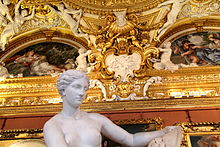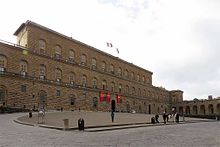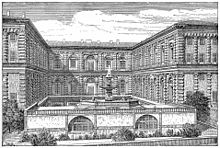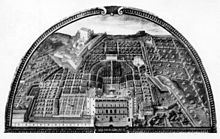Palazzo Pitti
Palazzo Pitti is a Renaissance palace in the Oltrarno district of Florence. Attributed in its basic structure to Filippo Brunelleschi, it was built from 1458 for the merchant Luca Pitti. The palace is the largest building of this district on the southern side of the Arno.
The consistent use of roughly hewn stone ashlars (ashlar work) as the only façade decoration on all three floors, which are very similar to each other, is striking and gives the building the fortress-like character typical of the buildings of the Florentine nobility (here lies an essential difference to the Palazzo Medici-Riccardi and the Palazzo Strozzi).
After the Pitti were convicted of participating in the Pazzi conspiracy, the building remained unfinished for almost a hundred years. Only after it was sold in 1549 to Eleonora of Toledo, the wife of Cosimo I de' Medici, was work begun on alterations and extensions and the creation of the Boboli Gardens. The Florentine rafter roof was replaced by a lower one hidden behind balustrades. In 1568 Bartolomeo Ammanati inserted Renaissance windows in the walled-up arched portals of the ground floor. He was also responsible for the garden façade, the design of the courtyard and parts of the gardens. The main building, originally three-storey with seven window axes, was enlarged between 1620 and 1631 to a width of 13 window axes and supplemented by two two-storey side wings, each with five axes, which seamlessly continued Brunelleschi's and Ammanati's façade design. The last of these was followed in 1764 by single-storey side extensions with arcades framing the forecourt.
In 1565 Giorgio Vasari built a long corridor across the Ponte Vecchio, connecting the Palazzo Pitti with the Palazzo Vecchio on the other side of the Arno via the Church of Santa Felicità, the Ponte Vecchio bridge and the Uffizi. This allowed the palace residents to commute between their residence and the town hall unmolested by the common people.
Palazzo Pitti was the residence of the Dukes of Tuscany from the 16th century, and later the Florentine residence of the King of Italy. King Victor Emmanuel III ceded it to the Italian state in 1919 - since then the Palazzo Pitti and its collections of paintings have been open to the public, including the Medici's Galleria Palatina with works by Titian, Giorgione, Raphael and Rubens, and the Galleria d'arte moderna with works from classicism to the beginning of Italian futurism at the turn of the 20th century.

Inside the Palazzo

The garden facade today

Main facade of the Palazzo Pitti

Ammanati's garden facade

Palazzo Pitti with Boboli Garden around 1600
Exhibitions and museums
The Palazzo Pitti houses the following museums and permanent exhibitions:
- Galleria Palatina (Medici collection of paintings)
- Galleria d'Arte Moderna (paintings from classicism to neoclassicism)
- the Costume Gallery (Galleria del Costume)
- the Porcelain Museum (Museo delle Porcellane)
- the Silver Museum (Museo degli Argenti)
- the royal apartments (Appartamenti Reali)
- the Carriage Museum (Museo delle Carrozze)
A side wing of the building houses a station of the Carabinieri, made famous by the detective novels of the British writer Magdalen Nabb.
The Palazzo Pitti was the model for the royal building of the Munich Residenz.
Search within the encyclopedia